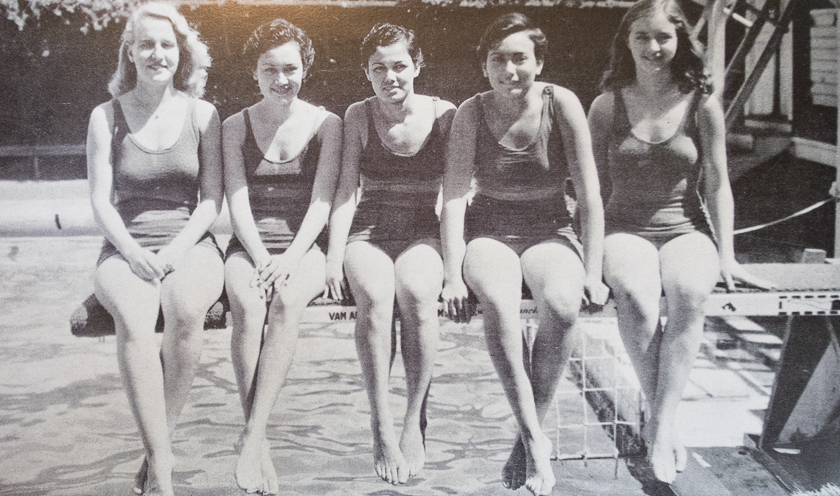My mother was born Helen Mililani Yonge on May 15, 1914. She died on this day, January 29, in the year 2013. She was just a few months short of her 99th birthday.
 I have a lot of pictures of her taken during that long life. I like this snapshot, taken on Kahala Beach somewhere around 1940-41. I’ll let it represent her for today.
I have a lot of pictures of her taken during that long life. I like this snapshot, taken on Kahala Beach somewhere around 1940-41. I’ll let it represent her for today.
She was born in Honolulu, grew up in Waipahu, boarded at Kamehameha School for Girls where she graduated in the Class of 1931, then attended the University of Hawaii at Manoa, earned a degree in Home Economics with a focus on nutrition, taught in the program for most of a decade, then got married and raised my sister and I at a small home my parents bought in Kahala. Near the end of her life, for a couple of years she could claim the title of “Oldest living graduate of Kamehameha.”
She taught me a fundamental lesson when I was probably six or seven years old and following her around the tiny kitchen asking nonstop questions about what she was cooking and how I could do it. Finally she stopped and told me the secret.
“If you can read, you can cook,” she said, introducing me not only to a couple of cookbooks that could be found in a drawer in the kitchen but also to her personal notebook, a small three-ring binder filled with her recipes, mostly typed and then edited with hand written notations based on subsequent experience. It’s a lesson that can be applied to other areas of life as well. If you can read, you can figure it out, you can do it on your own. Good advice!
She had been slowing down physically but remained mentally quite sharp until her final weeks. Around Christmas 2012, she was still keeping meticulous track of all household expenditures. In her papers, I found notes recording the amount spent for stamps to mail a couple of payments and a few holiday cards. Down to the penny spent, in her own hand. She ended up in hospice care in Palolo Valley after a fall in her bedroom. Within a week, she was gone.
On January 24, just four days before she died, I described an experience sitting at her bedside in the hospice house. I can still remember the moment. I suppose that makes it worth sharing.
I spent time at my mother’s bedside mid-day yesterday. One of our cousins had visited earlier and my mom was, as they say, unresponsive. She slept, and when her eyes opened, she didn’t connect. On the positive side, she’s comfortable, clean, and is periodically offered tiny bits of apple sauce and water, although she has mostly been refusing them. Yesterday I bought some poi, and my sister, Bonnie, took it up late in the day.
In hospice, the patient decides. Whether to eat, drink, to prolong life or not. Their choice. These are the few choices one can still make at this stage of life. It’s hard for us, those who can only wait and watch. But it is what it is.
After I had been there for a while, my mom opened her eyes, but they had that vague, cloudy, blank look. She barely responded, if at all, when I held her hand and told her I was there. She drifted in and out, closing her eyes, sleeping, then drifting back, eyes opening.
According to the hospice staff, she hadn’t spoken since arriving there early Monday morning. This was Wednesday.
So I was startled when she suddenly became agitated. Her eyes cleared as she looked across the room, then she unsteadily raised a hand, pointed.
She spoke, the words slowly bursting into the room. She struggled to get them out.
“Wait!”
“Don’t go!”
“Come back!”
Then she sort of relaxed back into the pillows, but her eyes were still bright and clear.
Her right arm was still raised, and this time she pointed to the foot of the bed.
Her voice was pretty clear, stronger than I could possibly have expected.
There was wonder, and loss, perhaps disappointment.
“He was right there,” she said, pointing to the foot of the bed. “Right there.”
She was speaking to herself, but I tried to gently ask who “he” was. It was enough to break up the moment.
She faded, eyes slowly closing, energy spent.
In the weeks before my father died, he referred several times to the people that were waiting for him. One day he asked me who was in the hall waiting to see him. Another time he said they were waiting in the next room.
“I really should go,” he told me, his tone of voice serious.
I don’t know what, or perhaps who, my mother saw. I don’t know if it was all part of a dream, or a glimpse somewhere into a world awaiting her arrival.
Believe not without evidences. But are these hallucinations or evidences? I suppose we’ll never know.





